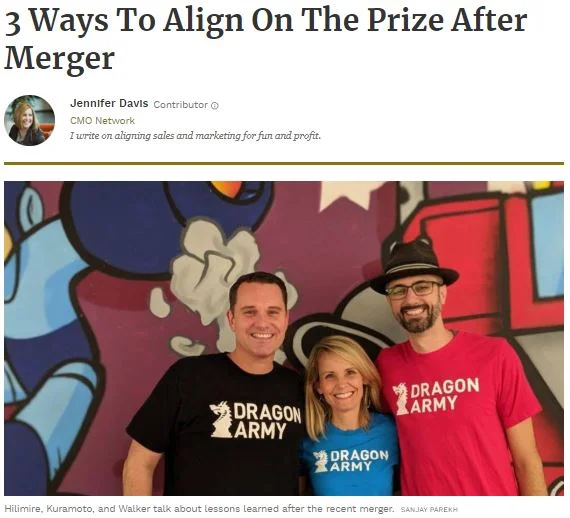Jeff Hilimire and his marketing agency, Dragon Army, knows something about change. The firm had already earned the distinction of the fastest growing agency in Atlanta for the years 2016-2018, when Jeff and his management team considered acquiring two new agencies, at the same time. Watchword, a branding firm founded by Rachelle Kuramoto, and Atlanta web design agency Sideways8, led by Adam Walker, were established and well-respected when they joined forces with Dragon Army earlier this year. The three of them talk about how they maintained cultural alignment and customer-centricity amidst change.
Weave a Culture that Works
The first and last thing to consider in a merger or acquisition is company culture and this one benefited from familiarity and respect. “The three of us had gotten to know one another over a number of years collaborating on client and philanthropic efforts,” said Kuramoto. “Our values and respect for one another have formed the connective tissue during this process.” This was illustrated in their integration process and in the results to date. “We started by making sure the leaders at the top of each organization fit the company culture,” recalled Walker. Once that was established, then leadership teams and all of the employee base was considered. “In the end, it was an amazing fit all around and the merging of the companies has been very smooth,” he said. But smooth integration after a merger comes with a lot of work.
Finding the initial common ground required a look at the company values and leadership styles. Hilimire speaks often about PVTV, which stands for Purpose, Vision, Tenets, and Values, a series of guiding principles and guardrails that he outlines in his recent business fable book “The 5-Day Turnaround.” Hilimire describes two of Dragon Army’s values as “team first” and “think positively.” These combine to create a powerful recipe for positive change management when team members are “able to accept the changes, see the path forward, and encourage other teammates to see the way through in a productive way.” Regularly pointing employees back to the PVTV “continues to guide us and shepherd us through the transition,” Hilimire notes. They serve to “remind people how to behave and work together.”
Kuramoto said that they “spent a lot of time ahead of the acquisition giving people a chance to know each other” in order to begin the endeavor with strong relationships, even with people who were remote. Making choices about what to do next was made clearer with leadership alignment. Kuramoto said they “put a lot of rigor into when, how, and why we meet at leadership, and much of that time has been focused on prioritizing, setting objectives, and staying on track.”
Take Away:
Spend time on the purpose and values of the company. When adopted at all levels and across all locations they will help to do the work of alignment.
Practice Change
Walker noted that the leadership style and structure across all three companies had not been overly hierarchical which helped prepare the organizations for change. “We embrace a node leadership structure with coaches leading teams of people.” The teams are dynamic allowing them to “flex and bend, but also scale, as needed.” Kuramoto noted that paying attention to each other during the merger and now in operating mode requires some regular practices. “As an expanded team, we do many things to attune to one another as people, from a weekly huddle during which we discuss every important detail and allow for questions to highly agile processes. From Slack channels like #nodumbquestions to regular team round tables dedicating to articulating what’s making people happy, challenged, and available to one another.” Walker credited the regular team check-ins as being critical. “Also, creating documents outlining any struggles and our plans to fix has helped a lot,” he added. “Just having issues written out where people can really see and understand them builds a lot of momentum towards fixing them.” Kuramoto noted that having things documented also helps not having to answer questions multiple times and helped integrate their remote workforce with their physical one. “We’ve had lots of conversations and learned what to put in writing to make everyone feel secure and empowered.”
Take Away:
Have communication mechanisms in place that will scale. Write things down. Create documents for problem solving and communication, as a form of inclusion to remote employees.
Create New Opportunities | Minimize New Distractions
The strategy behind the merger was to provide a greater capability to serve a larger customer base. “We brought together agencies that worked with small to mid-sized companies and agencies that worked with larger companies,” Walker observed. “This enabled us to work on projects small and large while also dramatically expanding our service offering.”
However, in times of change, the focus can shift internally and away from maintaining momentum on new business. To minimize this distraction, the team implemented road shows to clients, “introducing them to the new team members and talking with them about the changes, specifically focus on how the changes would positive affect them,” Hilimire said. Kuramoto added that “once the deal is done, the number of details involved in the M&A transaction is monumental. As a leader in the organization, you’re accustomed to putting the lion’s share of attention to client service excellence, team members, and growth.” So things like integrating timekeeping software platforms, making sure roles across the company are similarly defined, or aligning internal communications, although critical, can consume the leadership capacity. “Operational to-do lists can’t distract from those customer priorities,” Kuramoto noted, “so it made for a few weeks of long days.”
Reflecting on lessons learned, Hilimire noted that he would have focused more on ensuring growth without disruption. “Growth is important for many reasons, and can be the lifeblood of an agency,” he explained. Kuramoto added that Dragon Army is committed to grow through relationships and that the “whole leadership team, led by Adam in his specific growth role, helps to nurture new and organic growth through relationship-based activities like board work, networking, speaking, and supporting endeavors and causes that are important to our partners.” This helps ensure growth is on the top of the agenda.
Take Away:
Never take your eye off the company’s growth engine. Know your levers for growth and keep management attention there.
— — —
This article was originally published on Forbes.com.

















